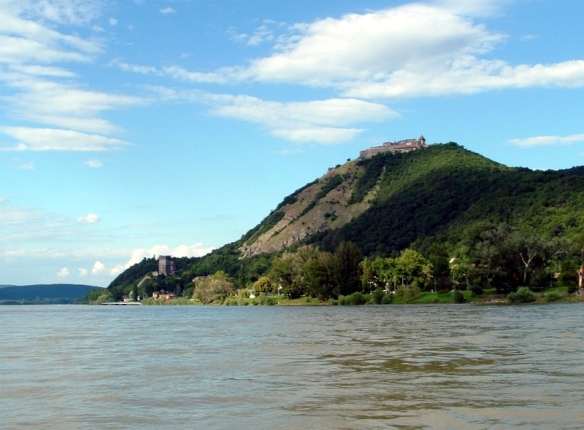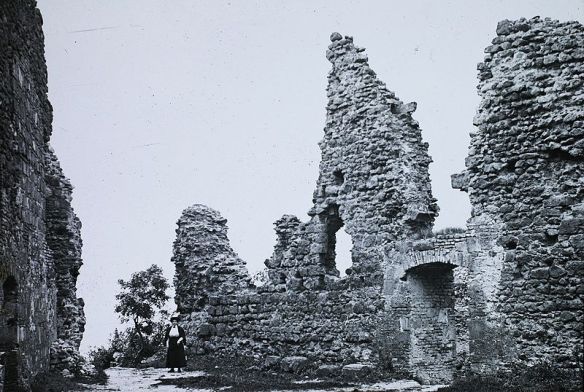A foreign visitor to medieval Visegrad once described it as a paradise on earth. I did not have quite that same feeling during my visit to modern Visegrad. Almost five hundred years of wear, tear and warfare has done a great deal of damage to the once formidable citadel. What I saw while visiting the upper castle (citadel) was a rough approximation of the magnificent fortifications that made Visegrad impregnable to medieval conquerors. The idea of Visegrad’s impregnability has long since passed into history. Nevertheless, those remnants left standing today are still impressive. One look at the citadel, surpassed only by the sky which its reconstructed ruins seemed to reach out and touch, must have defeated many an army. Unfortunately for Visegrad some foreign visitors did not hold it in high regard. The ruined condition of the citadel is due to those who saw it as a massive obstacle. As such, they decided to lay this island in the sky low. In 1544, the Ottoman Turks brought unprecedented military resources to bear upon the citadel. They soon found themselves standing within its battered walls. Keeping what they had conquered managed to be more difficult than they could have possibly imagined.
Possession of Visegrad was fluid, if not ephemeral over the period of Ottoman Turkish occupation in Hungary. The citadel changed hands several times during the wars which raged along a continually fluctuating border between Ottoman and Royal Hungary. In what amounted to a prolonged state of siege, the mighty citadel’s defensive works were eroded. By the time the Turks were driven out in 1685, the citadel had been rendered nearly useless for military purposes. Ironically, the Austrian Habsburgs who spearheaded the reconquest of Hungary decided to finish what the Turks had started. Ferenc Rakoczi’s War of Independence (1703 – 1711) against Habsburg rule sounded the death knell for any idea of the citadel’s reconstruction for martial affairs. The Austrians carried out a demolition to ensure that Hungarians who opposed their rule could not rebuild or refortify Visegrad. From that point forward, Visegrad’s history was frozen in time. Only at some undetermined point in the future would archaeologists, curators, preservationists and historians recreate Visegrad for those who would come out of curiosity or fascination with its conflicted past. This would be when the afterlife of Visegrad began.

River view – Visegrad as seen from the Danube (Credit: Horvabe)
A Commanding Presence – From Ideas & Insecurities
For me, the power of Visegrad’s citadel had little do with the ruins that still stand as silent witnesses or the interpretation of its history in museum exhibits. Instead, the true power of the citadel came from first looking up at it from the river below, then an hour later looking down from it back towards the Danube. Viewing the citadel from below makes it appear almost unattainable. There is a certain unreality to its presence. It is so perfectly situated atop Sibrik Hill that one must remind themselves that the citadel is not the product of fantasy or an overactive imagination. The citadel was born from deep rooted insecurities that fed into military strategy. It was placed high atop the hill as the most formidable line of defense. Visegrad, along with other hilltop fortresses, was King Bela IV’s response to the Mongol Invasion of 1241-1242 that had exposed the country’s paltry defenses. The idea behind medieval Visegrad was to save Hungary from another all-consuming cataclysm. Yet it is hard not to look up at Visegrad and think that it existed as much for aesthetic as defensive purposes such is the commanding position it holds over the entire area.
Getting to the top of the Citadel took an effort that expanded my lung capacity. The stairs inside the citadel were ultra-steep. Before long, beads of sweat began to form upon my brow as I ascended toward the highest possible point. There was nothing easy about scaling the heights of Visegrad. This physical exertion did more to communicate the difficult task would be conquerors must have faced. At the same time, it helped me realize just how powerful the Ottoman War machine was in its prime. Just to place the Citadel under siege, would have been a monumental military task involving logistics, weaponry and manpower that only one of the world’s great imperial forces could muster. The defenders seemed to have all the advantages, but I knew better. Visegrad was not the first or last citadel the Ottomans faced, but it was one of the most formidable.

Unreconstructed – Visegrad Citadel (Credit: fortepan.hu)
That Much Closer To Heaven – An Idea of Reality
Once atop the Citadel, the effect was spectacular. The beauty and scale of the scenery was more dramatic than I could have ever imagined. The Danube sliced through the heavily forested, sloping hillsides until they reached the quicksilver surface of the water. The late afternoon sunlight transformed the ribbon of river into liquid fire, gleaming and glowing with a blinding light. It was like staring at a sun emanating out of the earth. I walked to the edge of the walls overlooking the rock face falling away to the river far below. Here was an opportunity to stand in the same place where Hungarian warriors had awaited the enemy half a millennium earlier. Their perspective would have been in complete contrast to the same setting today. The peace and prosperity of the modern world makes the view from Visegrad’s citadel for tourists one of beauty and serenity. This is a highly deceptive, ahistorical perspective.

Crowning Achievement – Visegrad & the Danube (Credit: Civertan)
In 1544, those warriors would have been fighting for their lives. The citadel may have offered protection, but it was also a trap. For its defenders, there was nowhere to go except for down. Either to their graves or by falling into Turkish hands. Breaking a siege would have meant holding out for an indefinite period. That proved impossible. The defender’s final days would have been filled with fear and courage, terror and drama. These were the outstanding characteristics of a battle fought just below an impenetrable sky. The only saving grace for the defenders was that they were much closer to heaven when they met their final fate. This historically decisive moment was lost on me as I stared out from the citadel at the beautiful surroundings. The scene was so unlike the history that attended and ended this place that I found it hard to believe. Such was the power of Visegrad that imagination could not quite conquer reality.
